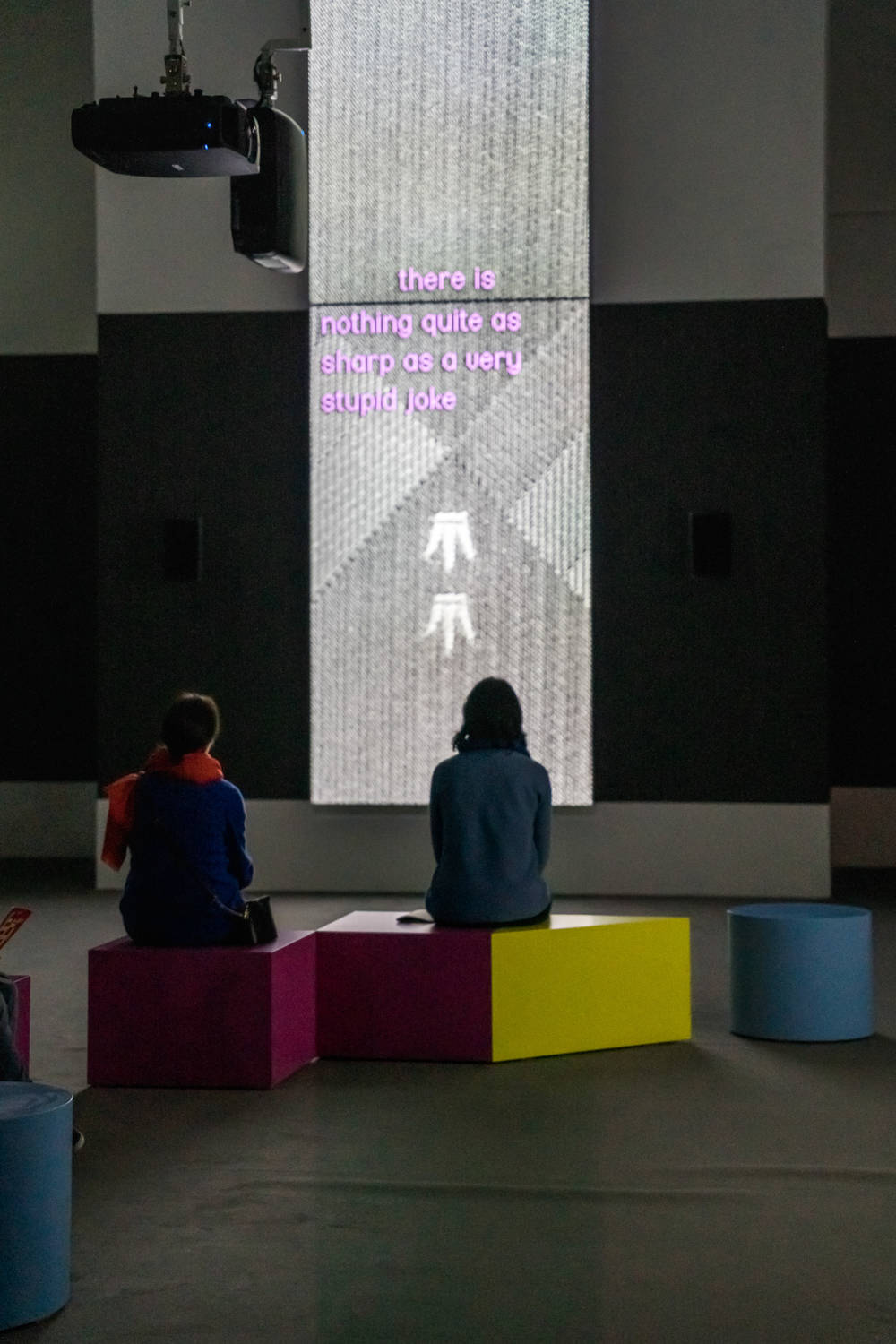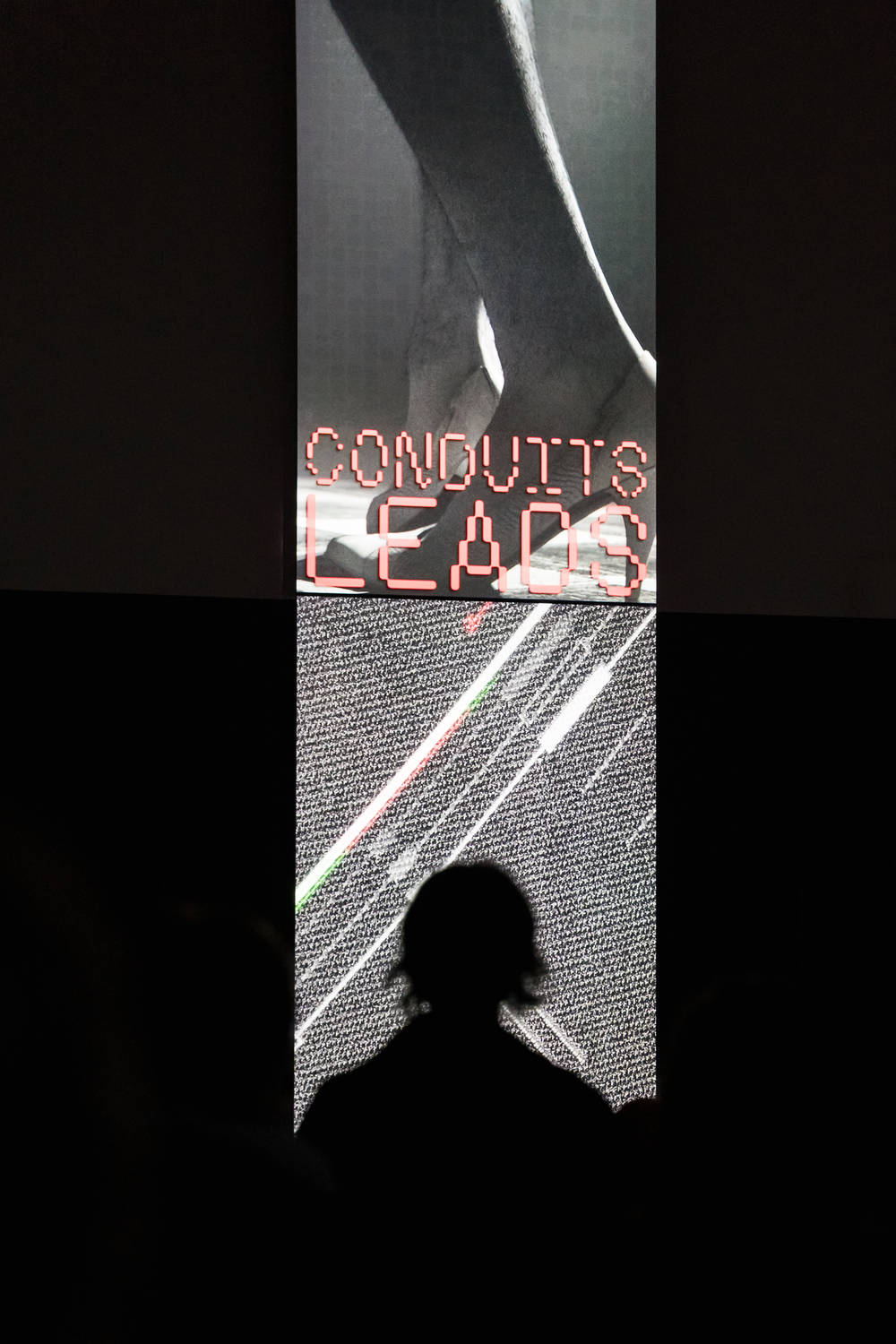Changes in the world of work and society are heralded in an almost invisible way in the fabric of material culture. Following precisely these traces is a specialty of Elizabeth Price – as she demonstrates with the example of the tie.
In her video work “FELT TIP” (2018), artist Elizabeth Price, who was born in 1966, uses the example of the tie to tell of a change in the world of work and society that is taking place in the wake of digitization and neoliberalism. However, she does this in the form of a science fiction story. From a two-channel video running in extreme portrait format – two monitors hang upright, one above the other – we hear a computer voice that could be construed as female, as well as much else on the soundtrack. A toggle switch clicks, then a computer’s fan starts whirring softly, a hard drive jerks. “This is the executive level”, begins the voice. Later, electronic music builds to a gradual crescendo, creating a narrative undertow that stands in strange contradiction to the cool, detached tone of the narration.
On felt-tip pens and ties
The title “FELT TIP” plays with a double meaning: On the one hand, a mysterious role is played by a thick purple felt-tip pen which, rendered in 3D, is dropped into an empty water glass. On the other, meanwhile, it relates to ties which, after all, are also not unlike pointed felt. The origins of the work are also twofold. A purple felt-tip pen caught the artist’s eye when she was buying a second-hand copy of Reimut Reiche’s Sexuality and Class Struggle, published in 1969. The previous owner (Price is certain it was a woman) annotated the text by the sociologist and sex researcher using a maximally conspicuous purple felt-tip pen. Price liked the ironic tone of the annotations and the irreverent treatment of the Marxist author’s writing. The second origin is Price’s personal collection of ties from the 1970s and 1980s – this video is about them. Black and white close-up shots of ties are superimposed, and the extreme format of the work returns to the elongated shape of this odd accessory once again.
Perhaps the shift within the world of work and life that Price describes has its origins in the changes in the British education system, which became more permeable and allowed more people – migrants and children of workers – access to universities and white-collar jobs. This was the result of to a series of reforms in the UK: 1962 saw the implementation of the Education Act, which gave students support through scholarships. Over the next decade, laws were then passed to ensure gender equality and prevent racial discrimination.

A social history of improvements and innovations
The narrator’s voice in Price’s video follows this social history, which testifies to gradual improvements and innovations within the professional world, with the help of patterns on ties. After all, in the decades before, the tie was a symbol of an elite with access to wealth and education, those who didn’t have to get their hands dirty in their work. However, gradually the old orders shifted and the world of work changed. Only the ties remained, like a remnant of old hierarchies. At least for a while. For the cultural signifiers which indicated membership of an educated elite changed – or, more precisely, they became trivial. The crests on ties that once signified membership in clubs, elite institutions, and aristocratic families were now embroidered on inexpensive, mass-produced goods: When ties became part of the office dress code, everyone needed one. Only the coats of arms no longer meant anything; what’s more, according to the narrator, they became a parody.
Price’s video tells of a dystopian mishmash within the world of life and work, the origins of which lie somewhere in the 1970s. Or perhaps even earlier, in the period after World War II, when cybernetics became the meta-science for many areas of society for some time, when the first room-sized computers with their punch cards soon made their way into the world of late capitalism. The flow charts of that time looked like circuit diagrams for computer chips in any case. Somewhat later, also in the late 1970s, painters like New Yorker Peter Halley created paintings that were reminiscent of lines or cybernetic diagrams.
As if there were a new narrative that permeated all areas of visual culture, something also happened to tie patterns: They became more angular, more abstract. The coats of arms disappeared, and in their place emerged another symbol, like a small pictogram. This may be due to a renewed interest in the early 20th century avant-garde, Price admits in a lecture, but she actually has no doubt about what is really depicted here: a memory chip.
A counterfactual narrative
It is a bold thesis, which Price weaves into uncomfortable fiction by fabricating a previously hidden narrative of the 20th century. For despite the analog warmth that sometimes emanates from “FELT TIP,” and despite the almost cute story of clinging to old symbols, there is also a dystopia in the video. Price bends her source material into a counterfactual narrative that, like all good science fiction stories, is firmly grounded in our reality. The narrator, whose voice the artist has assembled from three different synthetic voices, talks about administrators whose bodies are used as repositories of information by overwriting their DNA with data – more precisely, the DNA in the cells of their fingertips. And that’s actually only a slight exaggeration, because in May 2021, an article in Scientific American touted the possibilities of storing data in DNA. It is less expensive and is energy-efficient, according to the article – only the accuracy of its reading still poses difficulties.

Enough with the bullshit jobs
In “FELT TIP”, just as in the world of the information economy in general, however, the question remains unanswered as to what exactly is being stored there. Yet that is perhaps beside the point, because since the rise of what anthropologist David Graeber calls “bullshit jobs” at the latest, the purpose of numerous forms of work has become questionable – not to mention their meaning for society. A bullshit job, according to Graeber, is a paid activity in which even the person doing it is unable to find sense – although they must pretend that they do. Graeber, incidentally, dates the origin of bullshit jobs to the same moment when Elizabeth Price pinpoints the emergence of the new, digital managerial class: in the late 1970s, when neoliberalism promised efficiency, when large parts of industry in the West were dismantled, and nowhere more radically than in Great Britain. Unions were disempowered, and fair wages were replaced by the promise that office workers would find meaning and a sense of belonging in their jobs. At the same time, there was an explosion of jobs in the information sector, which require specific expertise as part of so-called “knowledge work”. Graeber concludes that capitalism does not deliver what it promises, namely the creation of efficient, self-regulating work processes.

Perhaps Price’s critique goes in a similar direction. Her videos can be read as both ironic and playful, for somehow they are also about the trivialization of the working world, an environment in which male dominance is both ensured and subverted through the display of the tie, that age-old phallic symbol. In Price’s video, we see women’s legs in high heels running and prancing repeatedly across the top screen. The tie is now just an empty symbol, a bit like parts of the digitized world of work with its bullshit jobs. “The oldest, most worn-out joke,” says the narrator, “is still the tie itself.”









